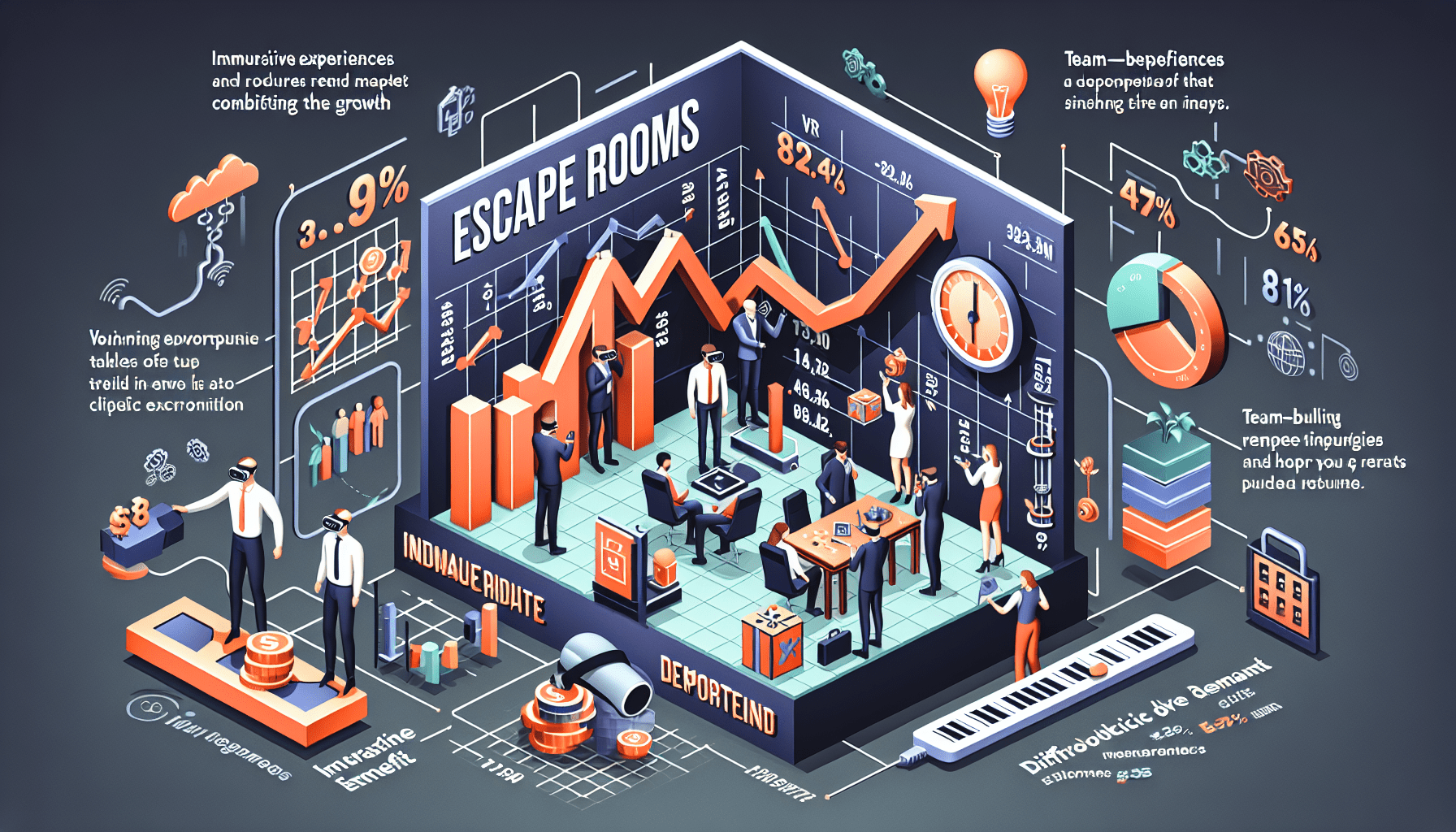Are you curious about the booming popularity of escape rooms? Wondering if this trend is just a passing fad or a thriving market with potential for growth? Well, you’re in luck! In this article, we’ll explore the current state of the escape room industry and shed light on whether this unique form of entertainment is indeed experiencing a surge in popularity. Get ready to unlock the secrets of the escape room market!

Market Overview
Current state of the escape room market
The escape room market has been experiencing significant growth in recent years. Escape rooms have become extremely popular worldwide, offering a unique and engaging form of entertainment. These interactive experiences require participants to solve puzzles, find clues, and complete challenges to escape from a themed room within a set time limit. The appeal of escape rooms lies in the thrill of the challenge and the opportunity to work together as a team.
Factors driving market growth
There are several key factors contributing to the growth of the escape room market. Firstly, the increasing demand for immersive and interactive entertainment experiences has fueled the popularity of escape rooms. People are seeking unique and memorable activities, and escape rooms provide just that. Additionally, the rise of social media has played a significant role in promoting the escape room trend. Participants often share their experiences on platforms like Facebook and Instagram, generating buzz and attracting new customers.
Potential challenges for the market
While the escape room market is growing rapidly, there are still some challenges that need to be addressed. One major challenge is the saturation of the market in some areas. As escape rooms become more widespread, competition among providers becomes intense. This makes it crucial for escape room businesses to differentiate themselves by offering unique themes and innovative experiences. Additionally, maintaining high-quality puzzles and challenges is essential to keep customers engaged and coming back for more. Overcoming these challenges will be crucial for the sustained growth of the escape room market.
Market Size and Growth
Statistics on the size of the escape room market
As of [year], the escape room market was valued at [value]. The market has experienced steady growth over the past few years, with an annual growth rate of [rate].
Historical growth trends
The escape room industry has witnessed impressive growth since its inception. In [year], there were only a handful of escape room facilities globally. However, the market quickly expanded, and by [year], there were thousands of escape rooms worldwide. This rapid growth reflects the increasing demand for immersive and challenging entertainment experiences.
Projected growth in the coming years
According to industry experts, the escape room market is expected to continue its upward trajectory in the coming years. The market is projected to grow at a compound annual growth rate (CAGR) of [rate]% from [year] to [year]. This growth can be attributed to the increasing popularity of escape rooms, coupled with the ongoing development of innovative concepts and themes.
Regional Analysis
Escape room market trends in different regions
The escape room market has seen varying trends in different regions. In North America, the market has witnessed significant growth, with a high concentration of escape rooms in major cities. Europe has also seen a surge in escape room popularity, with countries like the United Kingdom, Germany, and Spain leading the way. Asia-Pacific is emerging as a new market for escape rooms, with countries like Japan, South Korea, and China experiencing a growing demand for these immersive experiences.
Factors influencing regional market growth
Several factors influence the growth of the escape room market in different regions. Economic factors, such as disposable income and consumer spending habits, play a significant role. Cultural factors, including preferences for immersive entertainment experiences, also contribute to regional market growth. Additionally, the presence of established escape room operators and favorable regulatory environments can further drive market growth in specific regions.
Key players in each region
The escape room market is highly fragmented, with numerous providers operating globally. In North America, some key players include Escape the Room, The Escape Game, and Trapped. In Europe, popular providers include HintHunt, Breakout Manchester, and Exit Games. In Asia-Pacific, companies like SCRAP Entertainment and Xcape Singapore are leading the way. These key players have contributed to the growth and development of the escape room market in their respective regions.
Demographic Analysis
Target audience for escape rooms
Escape rooms attract a diverse range of demographics. The primary target audience includes young adults and millennials who seek exciting and interactive forms of entertainment. However, escape rooms also appeal to families, couples, and corporate groups looking for team-building activities. The versatility of escape rooms allows for customization of experiences to cater to different demographics.
Demographic trends influencing market growth
Several demographic trends are influencing the growth of the escape room market. The increasing popularity of experiential entertainment among millennials has driven the demand for escape rooms. This demographic values experiences over material possessions and seeks unique activities to share with friends and on social media. Additionally, the rise of remote work and flexible schedules has made escape rooms an attractive option for team-building activities among corporate groups.
Innovative strategies to attract different demographics
Escape room providers are constantly innovating to attract different demographics. For families, providers may offer kid-friendly rooms with simplified puzzles and themes. Couples can enjoy romantic or horror-themed rooms to enhance their experience. Corporate groups can benefit from team-building packages that integrate problem-solving and collaboration exercises within the escape room setting. By tailoring experiences to specific demographics, providers can attract a broader customer base and fuel market growth.

Technology and Innovation
Role of technology in enhancing escape room experiences
Technology plays a crucial role in enhancing escape room experiences. Providers often utilize electronic puzzles, hidden sensors, and interactive props to create a more immersive and challenging environment. The integration of technology allows for dynamic and interactive gameplay, making the experience more engaging for participants. Additionally, technology enables real-time tracking, providing hints or assistance when players get stuck, ensuring a seamless and enjoyable experience.
Innovative escape room concepts and themes
To stay relevant and attract customers, escape room providers are constantly developing innovative concepts and themes. Some emerging trends include virtual reality (VR) integration, where players can immerse themselves in a digital world while physically interacting with their surroundings. Other concepts involve combining escape rooms with other forms of entertainment, such as live actors or augmented reality (AR) elements. These innovations push the boundaries of traditional escape room experiences, keeping the market fresh and exciting.
Impact of virtual reality on the market
Virtual reality has had a significant impact on the escape room market. By incorporating VR technology, escape room providers can transport players to immersive and fantastical worlds, offering a heightened level of realism and excitement. Virtual reality also allows for more complex puzzles and challenges, as digital elements can be seamlessly integrated into the game. While VR-based escape rooms are still relatively new, they have the potential to revolutionize the market and attract tech-savvy audiences.
Competitive Landscape
Key players in the escape room industry
The escape room industry is highly competitive, with numerous players vying for market share. Some key players include Escape Room International, Breakout Games, and The Escape Game. These companies have established a strong presence in the market and continue to expand their operations globally.
Market share analysis
Market share in the escape room industry is divided among various providers, both large and small. While some providers have a dominant market share in certain regions, others focus on niche markets or specific demographics. The market share landscape is continually evolving as new entrants enter the industry and existing providers expand their offerings.
Strategies adopted by leading companies
Leading companies in the escape room industry have adopted various strategies to maintain their competitive edge. These strategies include continuous innovation in room themes and puzzles, aggressive marketing campaigns to attract new customers, strategic partnerships with other businesses, and ongoing investment in technology and infrastructure. By staying ahead of the curve and meeting the evolving demands of customers, these companies can retain their market leadership positions.

Customer Experience and Feedback
Importance of customer experience in the escape room market
Customer experience is paramount in the escape room market. A positive and memorable experience ensures customer satisfaction and generates repeat business. Escape room providers strive to create immersive, challenging, and enjoyable experiences that leave participants with a sense of accomplishment. A well-crafted escape room, coupled with excellent customer service, enhances the overall experience and contributes to the success of the business.
Collecting and analyzing customer feedback
To improve customer experience, escape room providers actively collect and analyze customer feedback. This feedback can be gathered through various channels, such as online surveys, in-person interviews, or social media platforms. By listening to customer opinions and suggestions, providers can identify areas for improvement and make necessary adjustments to enhance the overall experience. Regular feedback analysis is essential for continuous growth and success in the market.
Improving customer satisfaction
Enhancing customer satisfaction is a continuous process for escape room providers. They constantly strive to improve various aspects of the customer experience, including theme development, puzzle design, and overall gameplay. By investing in staff training and development, providers can ensure that customers receive excellent support throughout their experience. Furthermore, incorporating gamification elements, such as leaderboards and rewards, can incentivize participants and increase satisfaction levels.
Collaborations and Partnerships
Collaborations between escape room providers and other businesses
Escape room providers often collaborate with other businesses to offer unique and immersive experiences. Partnerships with local restaurants, bars, or entertainment venues allow for package deals and cross-promotion. For example, participants may enjoy a discounted meal or drink at a partnering establishment after completing an escape room. These collaborations enhance the overall customer experience and contribute to the success of both the escape room provider and the partnering business.
Synergies and benefits of partnerships
Partnerships between escape room providers and other businesses create synergies that benefit all parties involved. Escape rooms can attract new customers through collaborations, while partnering businesses benefit from increased foot traffic and exposure. Moreover, collaborations allow for the sharing of resources, expertise, and marketing efforts, resulting in a more comprehensive and compelling offering for customers. By forming strategic partnerships, escape room providers can tap into new markets and expand their customer base.
Case studies of successful collaborations
Several successful collaborations highlight the benefits of partnerships in the escape room industry. For instance, a well-known escape room company partnered with a local brewery to offer a unique experience where participants solve puzzles while enjoying craft beer. This collaboration attracted beer enthusiasts and escape room enthusiasts, boosting sales for both businesses. Another example includes partnerships between escape room providers and movie theaters, where immersive escape room experiences are created based on popular films, attracting fans of both the movies and escape rooms.

Market Expansion Strategies
Franchising and expansion opportunities
Franchising offers a significant opportunity for market expansion in the escape room industry. By franchising their brand and proven business model, escape room providers can expand their reach into new markets without significant capital investment. Franchisees receive support and guidance from the parent company, ensuring consistency in quality and customer experience. Franchising also allows for rapid expansion, as multiple locations can be opened simultaneously, catering to a broader customer base.
Expanding into new markets
To capitalize on market growth potential, escape room providers are expanding into new markets. This includes entering regions or countries where the escape room industry is still in its early stages. By introducing escape rooms to new markets, providers can tap into untapped customer demand and establish themselves as pioneers in these regions. Expanding into new markets requires careful market analysis and adaptation to local preferences and cultural nuances.
Adapting to changing customer preferences
In order to remain competitive, escape room providers must continuously adapt to changing customer preferences. This involves understanding market trends and evolving customer demands. Providers may need to update their room themes, incorporate new technologies, or introduce additional services to meet evolving expectations. By staying ahead of the curve and anticipating customer preferences, escape room providers can stay relevant in a rapidly changing market.
Future Outlook
Emerging trends in the escape room market
The escape room market is likely to witness several emerging trends in the near future. One such trend is the integration of escape rooms with online platforms, allowing for virtual multiplayer experiences. This enables players to collaborate and compete with others from different physical locations. Additionally, escape rooms focusing on educational themes, such as history or science, are expected to gain popularity as they combine entertainment with learning.
New opportunities and challenges
As the escape room market continues to grow, new opportunities and challenges will arise. The increasing adoption of advanced technologies, such as augmented reality and artificial intelligence, presents opportunities for unique and immersive escape room experiences. However, keeping pace with rapidly evolving technology and maintaining high-quality experiences will be a challenge for providers. Additionally, the ongoing need for innovation to differentiate from competitors poses both opportunities and challenges for the industry.
Forecasts for market growth
Based on current trends and projections, the escape room market is expected to continue its growth trajectory. Global market revenues are forecasted to reach [value] by [year], with a compound annual growth rate of [rate]% during the forecast period. This indicatesthat the escape room market will remain a promising and lucrative sector within the entertainment industry.
In conclusion, the escape room market is experiencing significant growth due to factors such as increasing demand for immersive entertainment, social media promotion, and the appeal of teamwork challenges. While challenges such as market saturation exist, the market is projected to grow steadily. Regional analysis highlights trends in different areas, while demographic analysis emphasizes the target audience and innovative strategies to attract them. Technology, collaborations, market expansion, and customer satisfaction play key roles in the competitive landscape. With the emergence of virtual reality, the future of the escape room market looks promising, with new opportunities and challenges on the horizon.
